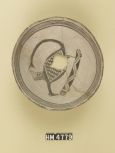Painted Imagery
 The images from pottery of the Mimbres Classic Period (A.D. 1000-A.D. 1150) present the best glimpse at Mimbres life and traditions. Figures depicted on the pottery represent scenes from everyday life, as well as mythological themes and characters. In addition to mastering the use of positive and negative space to create their designs and figures, Mimbres artists used the curve of the bowl and the positions of the figures depicted to lend a real-world perspective to their work. Though there is no clear lineal descent for the Mimbres, the best interpretations of the Mimbres’ images come from the oral histories and mythologies of the Pueblos of Hopi and Zuni.
The images from pottery of the Mimbres Classic Period (A.D. 1000-A.D. 1150) present the best glimpse at Mimbres life and traditions. Figures depicted on the pottery represent scenes from everyday life, as well as mythological themes and characters. In addition to mastering the use of positive and negative space to create their designs and figures, Mimbres artists used the curve of the bowl and the positions of the figures depicted to lend a real-world perspective to their work. Though there is no clear lineal descent for the Mimbres, the best interpretations of the Mimbres’ images come from the oral histories and mythologies of the Pueblos of Hopi and Zuni.
Many Mimbres bowls are decorated with a single figure, the majority of which are bird forms. The repeated depiction of birds (HM 95, 4775, 4779, 4785, 5099, 5100) on bowls found in graves may have symbolized passage into another world. Nonhuman mammals such as rabbits (HM 118), mountain goats (HM 107, 116), deer (HM 4777, 100, 113), and antelope (HM 4783) were also depicted. As rabbits are the most common of this group, it seems probable that the Mimbres depicted food animals. However, Brody theorizes, perhaps they merely painted animals that interested them since mountain goats were not highly prized for food. It is also possible that animals depicted had other meanings, such as association with year, month, or elements of the cosmic world. Rabbits, for example, often symbolized the moon in Southwestern and Central American cultures.
Insects (HM 108, 115, 106, 117), reptiles (HM 105, 4773), amphibians (HM 5101), and mystical creatures are depicted on approximately 25% of the figural Mimbres pottery found. In many cases, these animals and creatures are depicted as being morphed with another animal, or even a human. Such bodily combinations (HM 101) probably are representations of ancient evolution and emergence myths. Reptiles and amphibians in particular are often used as symbols for death and the underworld.
Though the myths vary in detail, it is generally believed by most ancient Southwestern cultures that people ascended from the underworld where they were created, passing through two unfavorable worlds, and finally into a fourth world that is earth. While in the underworld, the first people had many of the same characteristics as reptiles, but lost these traits as they climbed up to earth. At the top of the last ladder into the fourth world there was an exit hole called the sipapu that led them to the middle of the earth. However, the hole was very small and people needed assistance getting through the opening. In some stories the Hero Twins (HM 4781) pulled them through, while in others Badger digs the hole wider.
Fish (HM 4780, 4774, 4778, 99) were also commonly depicted on Mimbres pottery bowls. While many are images of the local Chihuahua Chub the Mimbres caught for food, two of the Palmer Collection bowls seem to depict more unusual species. One such bowl depicts a puff fish (HM 5102), something found only on the West Coast, and nowhere near the Mimbres homeland. This suggests the Mimbres possibly traveled great expanses to fish, or perhaps had contact with surrounding civilizations that could include puff fish as part of their daily life.
Human figures make up only about 15% of the painted figures, and date to the last 150 years of Mimbres civilization. The Palmer collection contains several of these figural pieces, most of which depict hunting scenes (HM 96, 114, 4782). Mimbres hunters used animal guises (HM 104, 5098) as a part of their hunting ritual. The idea behind wearing the mask of an animal during hunting—not necessarily that of the animal to be killed—was to encourage the prey to approach closer before it was killed. Though men were represented much more frequently than women, the Palmer Collection includes a piece depicting a scene that includes both sexes as they take part in important daily activities: weaving, child caring, and hunting (HM 1029).
